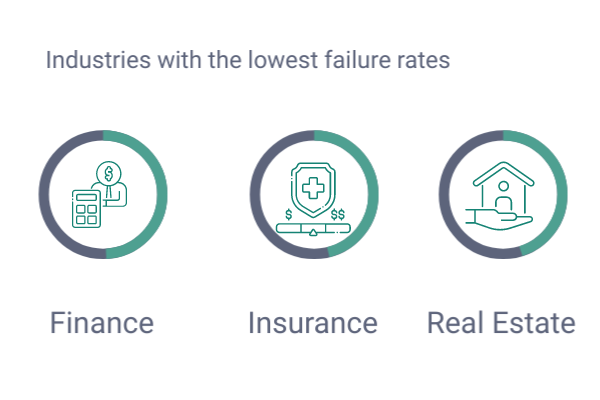

Updated · Feb 11, 2024
Updated · Aug 04, 2023
Harsha Kiran is the founder and innovator of Techjury.net. He started it as a personal passion proje... | See full bio
April is a proficient content writer with a knack for research and communication. With a keen eye fo... | See full bio
There are many reasons why people take the risk of building a business from the ground up, from freedom and flexibility to satisfy the urge to create the next big thing. However, the path to success is never easy.
Every year, around 305 million startups are funded globally. However, recent statistics show that 9 out of 10 startup businesses fail for various reasons. Only 10% surpass the challenges, and the rest will likely fail.
If you want to know what percentage of startups fail, this article will provide you with seven of the most recent startup failure statistics. Read on to learn more.
Editor’s Choice
|
Small business enterprises in the United States reached 31.7 million in 2022. Several enterprises were launched yearly. Unfortunately, the success rate is tremendously low.
Furthermore, the startup failure rate rises over time. Currently, 90% of funded startups fail annually, and only 10% will likely succeed.
This article will give you an insight into the significant statistics on startup failure rates and why success rates are significantly low.
|
👍 Helpful Articles: Thinking of building your own business? These articles are your jump-off point to get the ball rolling: |
90% of startups fail, constituting over 50% of all funded enterprises worldwide. The alarming statistics about the failure rates of these companies continue to grow over the years. These fail for many reasons, including:
This section includes recent studies on the percentage of startup failures, their reasons, and the industries' failure rates.
(Exploding Topics)
9 out of 10 new businesses fail within their first year of operation. This average failure rate is practical across all industries.
The first two years are critical since 20% of firms fail, and these situations continue to grow. Most entrepreneurs fail for various reasons, but poor business planning and management are the most prevalent.
(Exploding Topics)
According to the Bureau of Labor, a startup’s likelihood of failure increases over time. In their first ten years in the business industry, more than 50% of startups fail. Only 45% of new businesses survive past their fifth year.
Most startups fail, even if they have been in the industry for a long time since they need more investors to fund the business.
(LuisaZhou)
A 2019 research study shows that only 8.3% of entrepreneurs successfully create revenue-generating companies. This statistic equates to just 1 out of every 12 business owners.

Despite the low success rate, more and more startup companies are up for the challenge and continue to strive to achieve their business goals.
(LuisaZhou)
Failory’s recent study reveals that over 50% of startups fail during the first five years. And several reasons contribute to these startups' failures.
The fact that companies require more money yet cannot obtain further investment is one of the main reasons that over 30% of startups fail.
(LuisaZhou)
According to CB Insights, over 30% of startups fail because there is no demand for their product in the market.
However, things like these could have been avoided if a feasibility study had been conducted before launching the product. Studies or surveys like this are crucial to understanding your target market and determining your competitors.
(Failory)
Tech giants like Facebook and Google were formerly startups before they became billion-dollar online monopolies.
However, like other industries, entering the IT industry is full of risks and threats.
|
Industry |
Failure Rate |
|
Information industries |
65% |
|
Transportation and utilities |
55% |
|
Retail and construction industries |
53% |
|
Manufacturing |
51% |
The information industries face more failures than successes, likely due to more cut-throat competition and the overall speed of technological advances.
While many fail, those that succeed often face exponential growth, disrupt industries and bring about innovative change in the market.
(Failory)
Industries that primarily deal with money and essential goods are more stable than others. While it has had its fair share of triumphant ups and catastrophic downs, finance, insurance, and real estate show that they can weather the challenges posed by being rookie businesses.

Mining Industries have a 49% failure rate, wholesale Industries have 46%, and service industries have 45%. Agriculture, education, and health industries have a 44% failure rate, while finance, insurance, and real estate have a 42%.
While these industries have lower failure rates than the information and manufacturing industries, they aren’t entirely risk-free. For example, experts expressed concerns about a potential commercial real estate market crash in the coming months.
|
In the startup world, there are more failures than there are successes. Factors such as lack of funds and market instability contribute to such failures.
However, many of those who succeed end up as billion-dollar enterprises. With the high-risk, high-reward motivations of the startup world, it’s no wonder many still take the gamble of being the next big thing
Reasons for failure include running out of funds, being in the wrong market, needing more research, better alliances, inefficient marketing, and requiring more industry expertise.
75 percent of U.S. startups fail within the first 15 years.
Your email address will not be published.
Updated · Feb 11, 2024
Updated · Feb 11, 2024
Updated · Feb 08, 2024
Updated · Feb 05, 2024



